The glistening Adriatic Sea that surrounds Croatia has more than 1,200 islands and islets, which makes it perfect for a Croatia island-hopping adventure.
I know as I have seen most of them in my 20+ years traveling Croatia. This guide shows you how to island hop just a few of the 48 inhabited island Croatian islands.
I have chosen islands that you can ferry between, but hey, if you plan to sail Croatia on your yacht, even better.
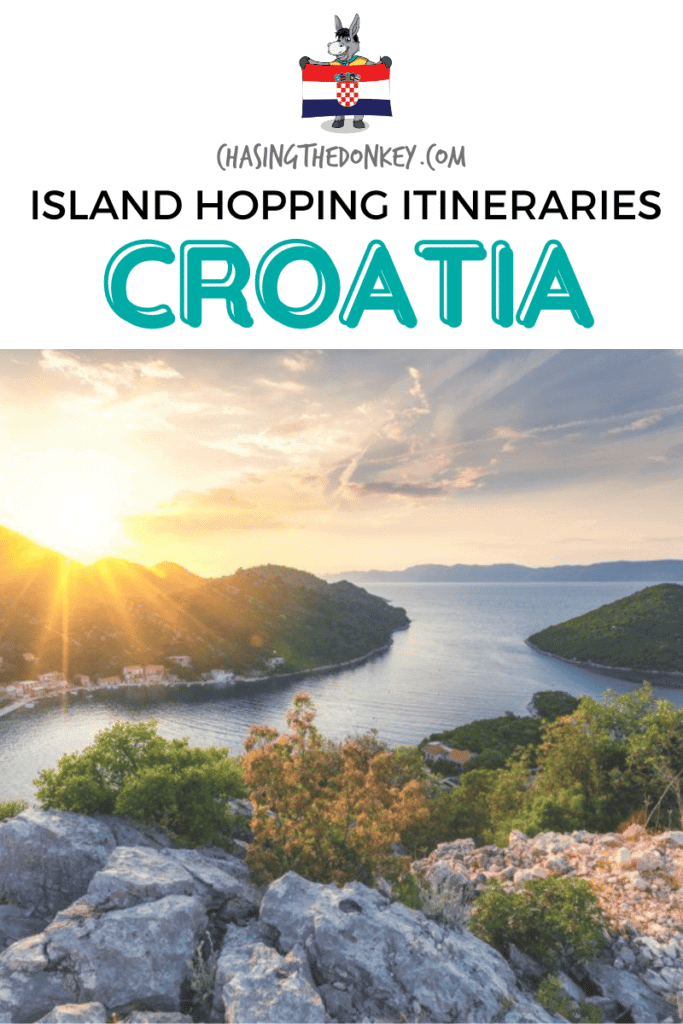
There are many islands to choose from for exploration, especially since each one packs a heck of a lot of charm, boasts unique summer festivals, and has stunning baroque architecture and Renaissance churches.
Choosing which Croatian islands to visit can be complicated when you factor in schedules, businesses closing in the off-season, and local festival dates; it can seem that creating a Croatian island hopping itinerary is impossible. But it is not with this guide.
My guide will help you determine which are the best Croatian islands for you.
This is the ultimate guide to island hopping in Croatia, providing you with three diverse itineraries to inspire your Croatian journey like a local!
I have purposely left off Split and Dubrovnik, as you already know, those two inhabited islands in Croatia, and more than likely, you will be starting or ending your trip in one of these two locations.
My itinerary options include an island or two you may not know; they are;
- Brač
- Cres
- Hvar
- Korčula
- Krk
- Lošinj
- Mljet
- Pag
- Rab
- Vis
Skip Ahead To My Advice Here!
3 Day Croatian Island Hopping Itinerary
This short itinerary designed for a weekend island hopping around Croatia will take you to some of the top islands to visit in Croatia – Krk, Cres, and Lošinj.
All three islands on this short island-hopping itinerary were ruled by the Greeks, followed by the Romans, Byzantines, Venetians, and Austro-Hungarians! Their common history gives them shared features, though each island is indisputably unique.
Forget about island hopping Croatia by boat this time, and rent a car to make the most of your short trip! When most people start to think about how to island-hop Croatia, ferries come to mind, but they forget that bridges connect a lot of the islands in the Kvarner Gulf.
Day 1 – Krk
Bustling Island With Lots Of Locals
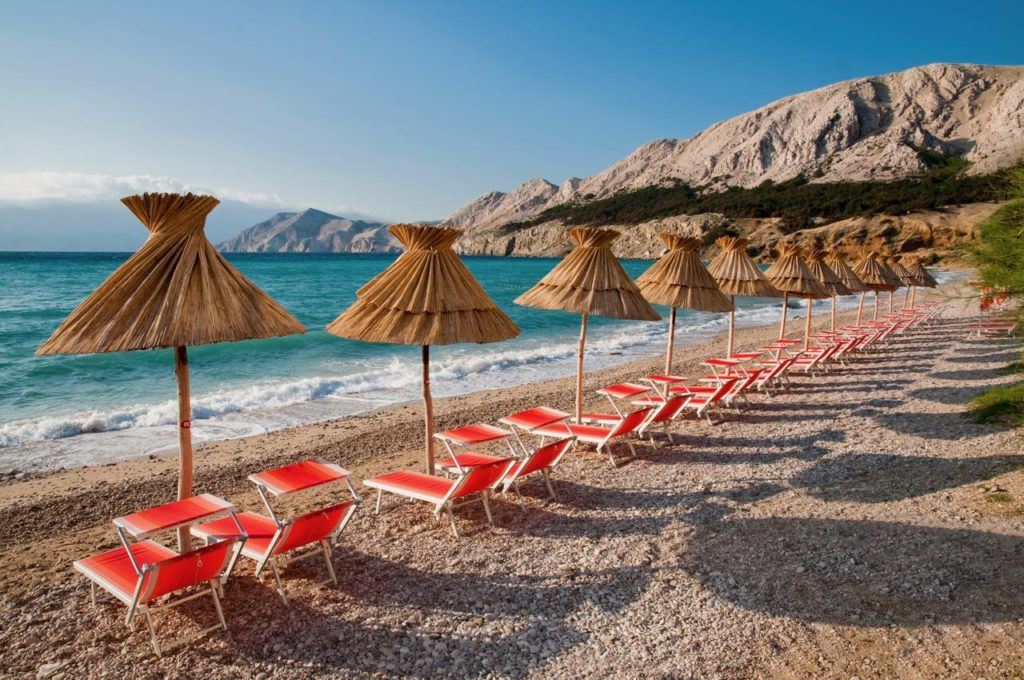
Krk is one of the busiest islands in the Adriatic, with almost 20,000 inhabitants. If you’re looking to get a real sense of what island life is like for the Croatians who call the Adriatic Sea home, Krk is the place to go.
Some towns worth looking into as potential places to stay are Vrbnik, Malinska (which is a city for any foodies out there!), Baška, which is super popular in the summer months thanks to all the gorgeous beaches that surround the town, and Krk town, which is nestled behind a fortified wall!
A little further out of the way is one of the lesser-known spots, the 1100-year-old Romanesque Catholic Church of St. Lucy near the charming old town of Jurandvor. The checkerboard pattern carved on the church’s bell tower is suspected to be one of the first examples of the Croatian Coat of Arms.
If you consider yourself a fan of everything history-related, you’ll also be a fan of the old Frankopan castle in the town of Krk that once belonged to one of the wealthiest families in Croatia.
There are a few ways to get to Krk Island. You can actually take a small aircraft from Split Airport and land directly on the island at Krk Airport, and the flights aren’t super expensive either! This is a good idea if you’re already traveling in Croatia and you want to save time.
If you’re following our ultimate guide and renting a car as suggested, your next destination is about a 45-minute drive away. Krk is linked to the mainland by a large bridge, so you can get there from Rijeka, even by bus, taxi, or bike! Alternatively, you could use the local ferry system.
To get off the island of Krk and continue your island hop in Croatia to Cres, take the ferry line 332 (cars are allowed on board!).
Day 2 – Cres
Quaint Towns & Excellent Cuisine
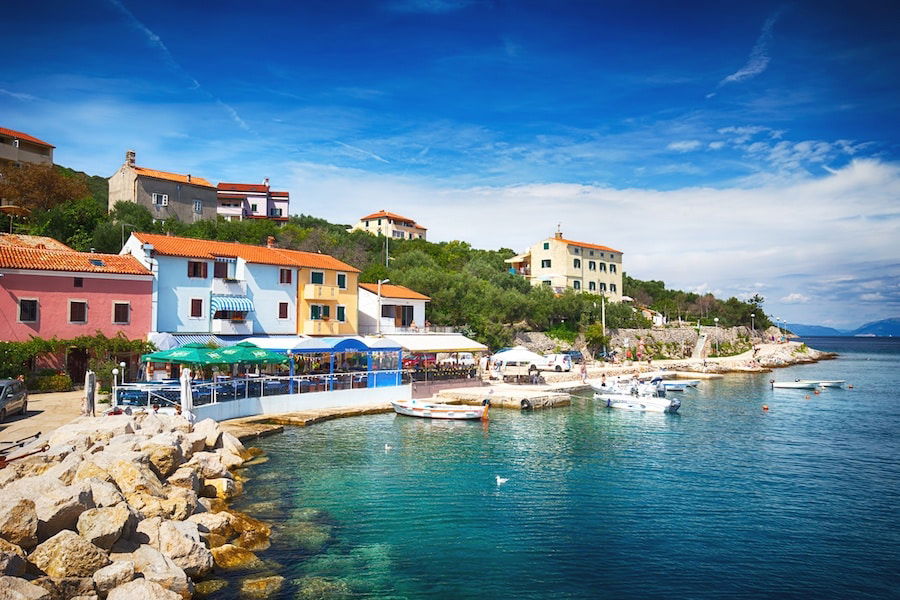
Cres is known for its quaint towns and vast stretches of oak forest. It’s also home to a population of griffon vultures that nest on the cliffs around the town of Beli.
If you want to sample some of the island’s finest gastronomy, try the different lamb dishes on offer and enjoy the fresh seafood. You might also notice that in Cres, the locals speak a dialect that sounds kind of Italian, which sounds very different from the Croatian spoken on the mainland.
Towns worth visiting include Cres town and Madrač, which are decorated with pastel-colored mansions left behind by the Italians that were there from the 15th century onwards.
Next stop? Lošinj! Cres and Lošinj actually used to be the same island, but they are now separated by an 11-meter-wide canal that was dug out by the ancient Liburni tribe near the town of Osor. Thankfully, there’s a little bridge connecting the two, so it’ll take you just minutes to get from one top Croatian island to the next!
Day 3 – Lošinj
Known For Sunshine & Clear Waters

The island of Lośinj was designated a health resort in 1892 thanks to the vast amounts of sunlight the island gets each year, the refreshing sea breeze, and the clear blue waters.
Once you’re on the island of Lošinj, visit the two most iconic towns – Mali Lošinj and Veli Lošinj.
In Mali Lošinj, it’s worth visiting the Kvarner Palace, which is home to the Apoksimen Men, an ancient Greek statue that is over 2000 years old and carved out of bronze.
Botanists are going to especially fall in love with Lošinj. There are more than 1100 plant species and 230 medicinal herbs on the island. If you want to see some of the coolest, visit the Garden of Fine Scents.
Other top attractions on the island include the protected area that’s home to a large dolphin population. Keep a lookout for these playful animals as you stroll along the shore!
To finish up your holiday, hop back in the car and make your way backward until you get to Rijeka!
5 Day Croatia Island Hopping Itinerary
To keep it simple, for a 5-day island hopping expedition in Croatia, I’d recommend you extend the 3-day itinerary and keep exploring the Kvarner Gulf. Unfortunately, the car isn’t going to be much use from now on as Rab and Pag, the following islands on the itinerary, are connected by foot passenger-only ferries.
Return the car in Rijeka, then hop on the ferry to Rab; it takes just under 2 hours, and Jadrolinija and G&V Iadera offer services. Be sure to time everything well, as there’s only one ferry per day!
We recommend you book your ferries with Ferryhopper in advance here.
Since you’ve got everything planned for the first three days, let’s jump straight to day 4.
Day 4 – Rab
Friendly Locals, Quaint Towns
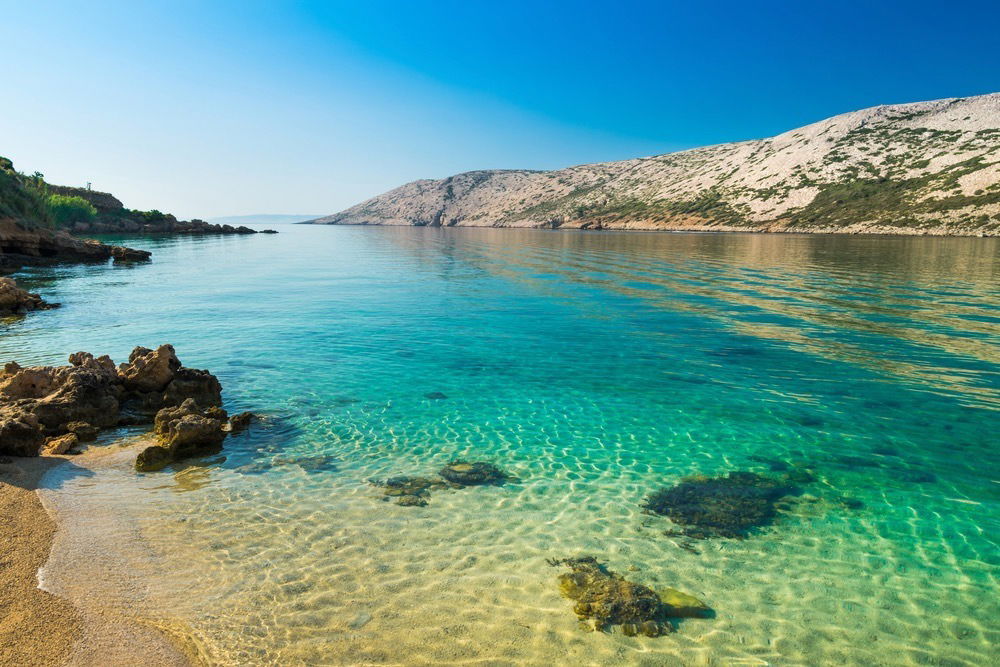
The towns dotted across the island of Rab are quaint and cute, made up of rows of terracotta-roofed houses and rising church towers! The locals are friendly and easygoing, and in summer, there are plenty of festivities you can get involved in, too.
Popularized after the visit of King Edward VII and his wife Wallis Simpson, this island is known for its nudist beaches, a trend that is rumored to have been kickstarted by the king himself!
One of the best times to visit Rab is between the 25th and the 27th of July, when the island comes alive in celebration of Rapska Fjera, the oldest and largest medieval festival in Croatia. Everyone gets dressed up in medieval attire, and there are craft stalls and workshops on every street. The wine is never scarce, either!
From Rab to Pag, there’s a foot passenger ferry that arrives in Novalja and is run by Jadrolinija. Again, there’s only one a day, so don’t miss it!
Day 5 – Pag
Mountainous, Narrow, Party Island

Pag is mountainous and narrow. Most of the island is made up of sleepy fishing villages, but even Pag has a wild side. The town of Novalja, where your ferry will arrive, is on the bucket list for anyone in Croatia to do some party island hopping!
Zrće Beach is just a short bus ride away, and it’s club-central! If you want to let loose and party Croatia-style, you won’t be short of options.
On the other hand, Pag also has a lot to offer in terms of culture and history. It’s fascinating watching the women sit outside on their porches and patiently stitch Pag lace, and the Gothic cathedral in Pag town is a charm.
Once you’ve explored Pag, you can catch a bus over the bridge that connects the island to Zadar, bringing your island hopping tour to an end in one of the coolest and lesser-known cities of Croatia!
We recommend you book your ferries with Ferryhopper in advance here.
7 Day Island Hop In Croatia Itinerary
For your 7 day island hopping tour in Croatia, I propose exploring the Dalmatian coast route that starts in cities of Split and ends in Dubrovnik, or doing it the other way round and traveling from Dubrovnik to Split - island hopping style.
This itinerary will take you to some of the best Croatian islands that attract large crowds in the high season, like Hvar, and to lots of smaller islands that aren't as famous, like Brač, Korčula, and Mljet, with the bonus of a day on Vis Island.
This 7 day itinerary will allow you to explore the islands off the coast of Dubrovnik and make your way along the Croatian islands accessible from Split. You'll be doing everything by boat, too, which only adds to the adventure!
Day 1 - Vis
Island For Nature Lovers
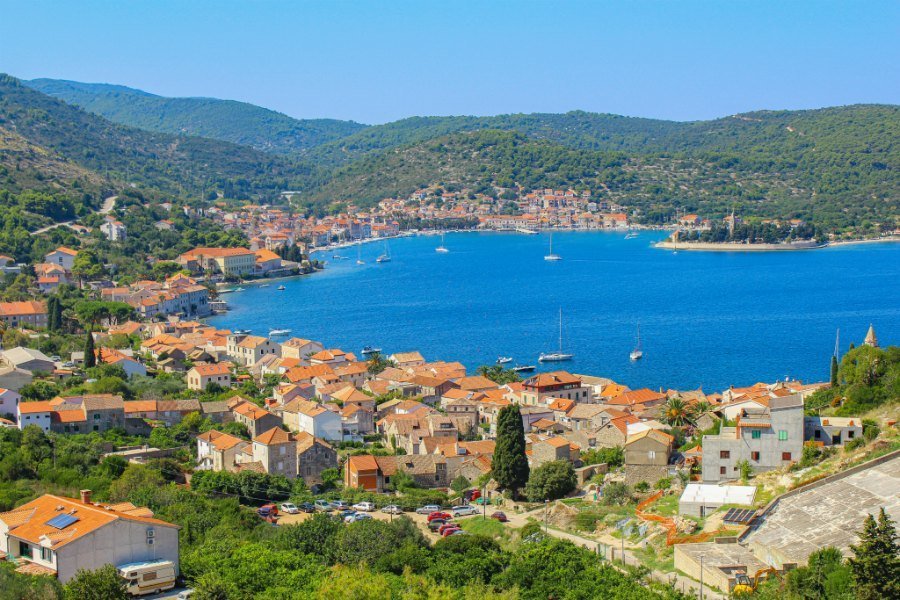
Between 1950 and 1989, Vis served as the Yugoslav National Army base, and no foreigners were allowed on the island. Now it's open to all!
Just off the shore of Vis is the incredible blue cave of Biševo. Make sure you take a boat tour to this remote cave that lights up in bright blue hues before you leave the island!
There are some cute towns on the island, too, but it's really the cave that draws visitors in. Towns worth staying in include Vis Town (which is where ferries from Split arrive) or Komiža.
Getting from Split to Vis isn't too complicated. There are a few options from the ferry terminal to Vis Town. Jadrolinija runs a year-round ferry, and the company Krilo runs a year-round catamaran. Bear in mind it'll be the longest of your ferry rides - it takes two and a half hours!
The biggest problem you'll have is leaving the island. In the peak summer season, there is just one ferry per day in the afternoon from the Vis ferry port to Bol on Brač Island. TP Line runs it, but off-season, there aren't any ferries at all, so your only option is to ferry back to Split and then catch another ferry from there to Brač Island.
Day 2 - Brač
Elevated Island That's Less Touristy
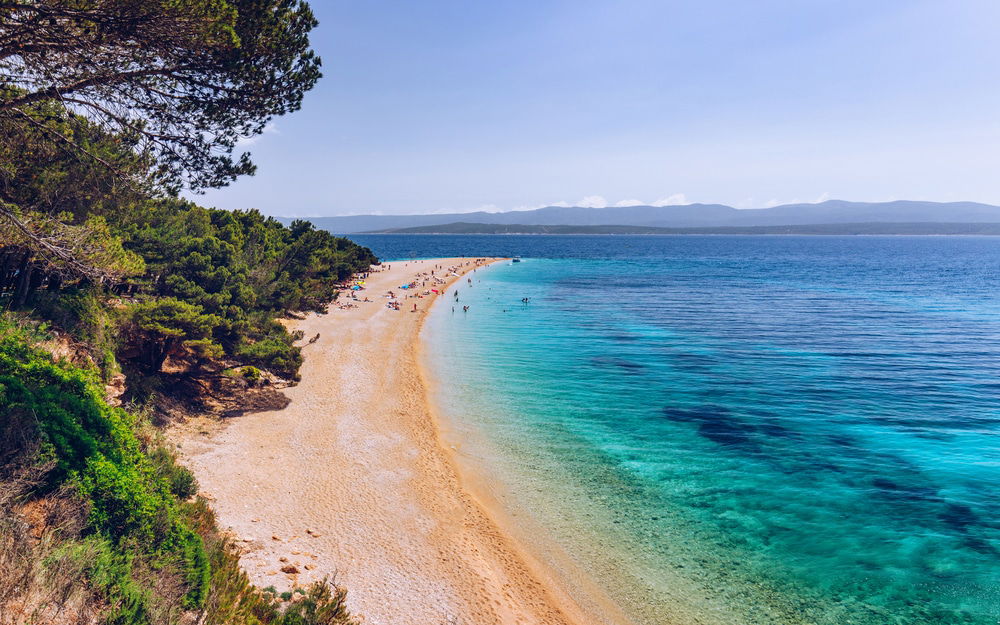
Zlatni Rat (Golden Cape or Golden Horn) famous turquoise beach in Bol town on Brac island, Dalmatia, Croatia. Zlatni Rat sandy beach at Bol on Brac island of Croatia in the summertime.
Inhabited since the Neolithic age, this long and narrow island is less touristy than a lot of the other islands despite being the largest of the central Dalmatian Islands, which makes it an excellent destination for less social travelers.
It's home to the highest mountain of any of the Adriatic islands, the Vidova Gora (which stands just 780 meters above sea level and can be climbed in a short hike), and it even has its own airport! But it's still less fancy than Hvar.
Speckled with olive groves that were planted by the Greeks hundreds of years ago, the island produces a large amount of olive oil and has a quintessentially Mediterranean feel to it.
The main town is Supetar, which will also be your entry and leaving point to and from the island. It's a convenient place to stay the night, too, so you don't have to move all your luggage around. But try to check out the medieval town of Skrip, too, if you have the time!
More in a beach lounging mood? Head to the Zlatni Rat beach. It gets a little crowded in high season, but it's one of Croatia's best sandy beaches, and there's some great snorkeling just off the shore.
Another great thing about stopping over in Brač for a night as part of your island hopping holiday is that you're just a 30-minute ferry ride the next day to your next destination, the famous Game of Thrones location. Island of Hvar!
Day 3 and 4 - Hvar Island
One Of The Biggest, Most Popular Islands
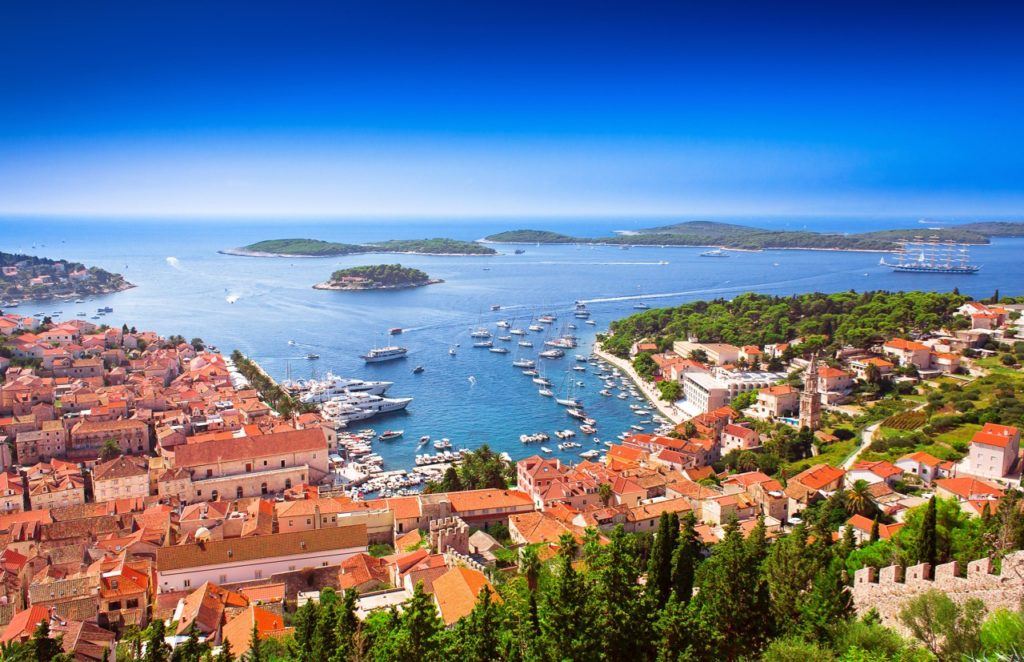
One of the bigger islands, the island of Hvar, has a great deal on offer, which is why it's worth spending two days here to get a real sense of the different facets of this remarkable island.
Throughout its history, the island was ruled by the Illyrians, Greeks, Romans, Byzantines, Croatians, Venetians, Austrians, French, and Italians - so its culture and heritage are very diverse.
The local islanders are super friendly and welcoming, which makes everything more fun!
If you're in Croatia to party, stay in Hvar Town. It's a little more expensive than some of the other popular towns, like Stari Grad and Jelsa, but it's also bigger and busier so there is way more atmosphere!
Some of the most famous clubs on the island include Carpe Diem, Splash, Hula Hula Beach Bar, and Falko Beach Bar - get ready to boogie the night away!
On the other hand, if you're trying to get away from the crowds, then head to one of the small fishing villages on the island and enjoy some solitude. Top choices include Vrboska, Milna, and Sveta. You might need to take a taxi to get there once you arrive at the port, but the great thing about islands is that nothing is ever too far away!
Nature lovers, be sure to check out one of the lavender fields and go on a hike up to the Spanjola Fortress.
Wherever you decide to stay, it's worth visiting the main historical sites, like the Stari Grad plains, which are a UNESCO World Heritage Site, and the Hvar theatre, which was constructed in 1612.
From Hvar, the next island on your Croatian island-hopping itinerary is the island of Korcula; it's just a one-and-a-half-hour ferry ride from Hvar Town.
Day 5 - Korčula
Popular Island Known As Little Dubrovnik
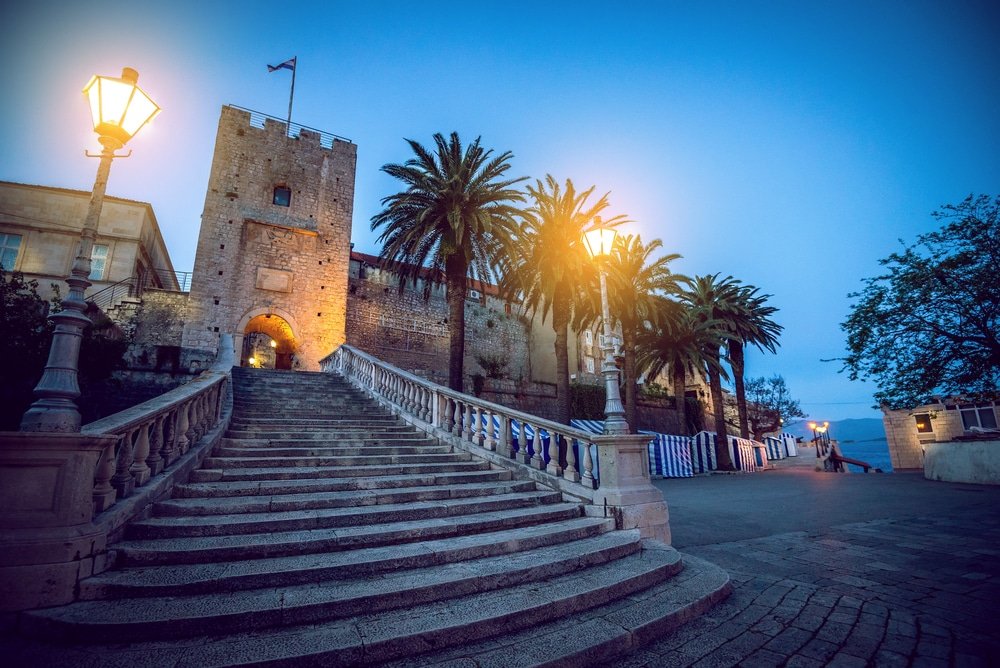
Korčula Town has old city walls running along the edge of the Croatian coast and is somewhat reminiscent of Dubrovnik, earning it the nickname "little Dubrovnik," but thankfully, there are considerably fewer people around!
There are cute medieval squares, rows of terracotta-roofed houses, and quaint churches all over the old town. Oh, and did you know it's rumored to be the birthplace of none other than Marco Polo?
If you're visiting in high season, see if you can get a Korcula Yellow Taxi ticket; that way, you can hop on and off at four of the main attractions with ease and save time and money!
The next day, catch a quick half hour ferry from Korčula port to the Pomena port on Mljet island. Warning: there are no ferries in winter, and in high season, there is just one per day! So don't miss it if you need to stay on schedule.
Day 6 - Mljet Island
Small Island - 1000 Inhabitants
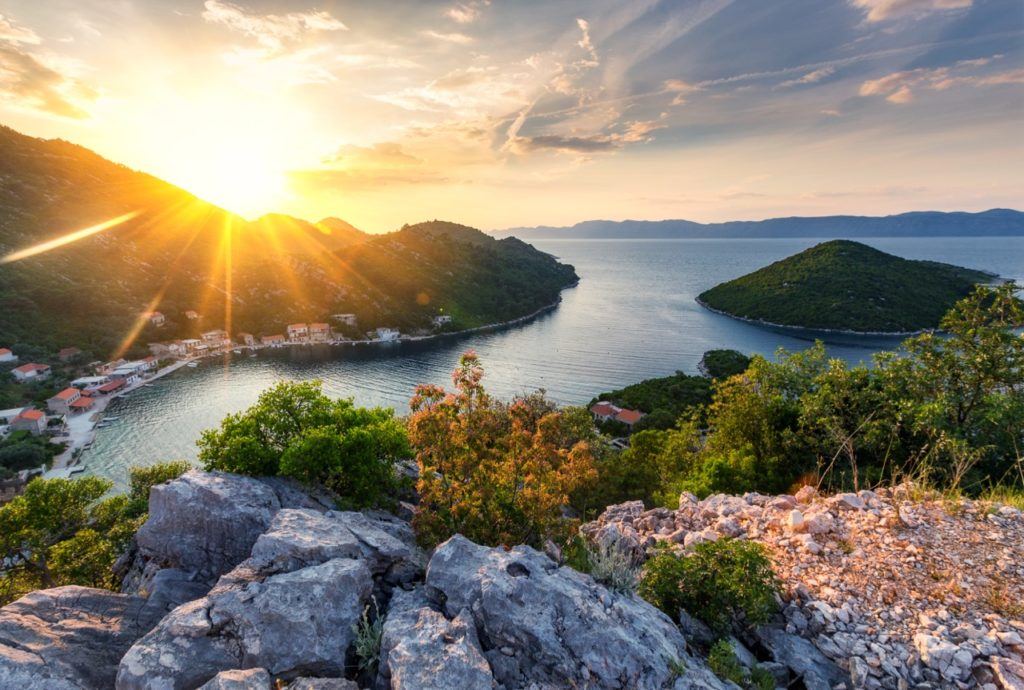
The little island of Mljet is home to as few as 1,000 people. It's tranquil and ideal for nature lovers and avid hikers who want to check out one of the less done-up islands and hike to the famous Odysseus Cave.
Half of the island is a National Park, which encompasses two inland saltwater lakes (Veliko and Malo Jezero) as well as dense Mediterranean vegetation.
On Mljet, the most challenging decision will be whether you spend the day hiking, kayaking, snorkeling, or reading and sunbathing on a sandy island beach!
The next day, wake up early and catch the ferry from the Sobra port in Mljet to Dubrovnik; it takes just an hour to an hour and a half, which will be a relief if you tend to get seasick!
Day 7 - Dubrovnik & Lokrum Island Croatian Hub + Uninhabited Island
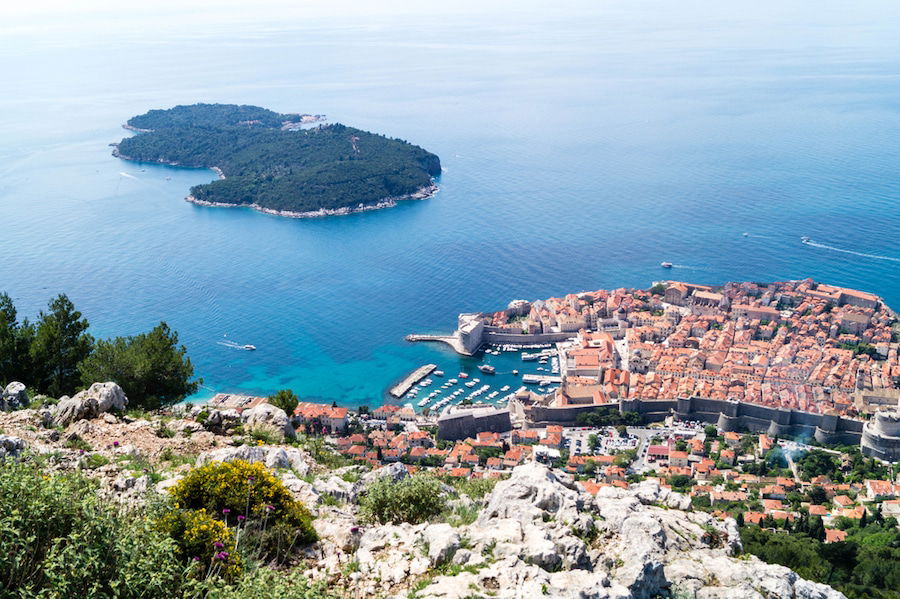
Dubrovnik is one of the most popular cities in Croatia; it has a long history that dates as far back as the 7th century, so history buffs will be especially enchanted by the old city walls (which you can tick off your UNESCO World Heritage Site checklist!) lined with restaurants and points of historical interest.
Dubrovnik gets very busy in the summer, as cruise ships loaded with passengers and tourists flock in, but there's a good reason people come to Dubrovnik - it's gorgeous.
You have a few options on your last day - you can take the cable car up Mount Srd for great views, chill out in the city, and catch your breath, or if you're determined to see as many islands as possible, then we have a treat in store for you.
Just a 15-minute ferry ride away from Dubrovnik's port, and you're on Lokrum Island! It's one of the many uninhabited islands in the Adriatic Sea, which reeled me in because of the inland saltwater lake and nudist beach! There are also the crumbled ruins of an old Benedictine Monastery you can explore.
Brands We Use And Trust
What Is The Best Way To Get Around The Islands In Croatia
The best way to get around the Croatian islands largely depends on your itinerary and preferences. For the most part, ferries are a reliable and scenic option, connecting the mainland to various islands and providing inter-island services.
If you're island-hopping in the Kvarner Gulf, for instance, you can easily drive across bridges to some islands like Krk. In more remote areas, smaller boats and catamarans are handy.
Renting a car can be useful for exploring individual islands extensively. Ultimately, combining ferry rides with local transport or car rentals offers a flexible and comprehensive way to enjoy the diverse landscapes and experiences each island offers.
Move This Adventure To Your Inbox & Get An Instant Freebie

No spam. Unsubscribe at any time.
When Is The Best Time To Island Hop In Croatia?
The best time to island hop in Croatia really depends on what you're looking for.
If you're into nature and prefer cooler temperatures for activities like hiking or cycling, then spring and autumn are great choices.
Just keep in mind that during these months, ferry schedules might be less frequent, and some businesses might be closed.
Summer, on the other hand, is perfect for those who love a lively atmosphere and don't mind the crowds. It's the peak season, so everything's open, and ferries run more frequently.
However, be prepared for higher prices and more tourists.
If you're looking for a balance between nice weather and fewer crowds, late May to early June or early September to mid-October are ideal times to visit.
Island Hopping Holiday FAQs
Here are the most commonly asked Croatia island hopping FAQs
When to go to Croatia and for what?
Spring and autumn are great for nature lovers as the cooler temperatures are ideal for hiking and cycling, but the weather is still great for snorkeling.
The only drawback is going in these months will require more planning because of the irregular ferry schedules, and some tour operators, hotels, and restaurants have started to close.
Summer is for partying, and the islands have a more lively atmosphere. Another appeal is that everything is in full swing, and there are more ferries. But on the other hand, it is more crowded, and prices skyrocket.
Is one week enough to island hop in Croatia?
While you can definitely get a good island trip in during a 7 day adventure, we’d recommend pairing it with some mainland exploration. Two weeks in Croatia is ideal if you want island and mainland experiences.
What are the best islands in Croatia?
In the top three are Rab, for the top cultural festival, Korčula for unmatched charm, and Hvar! Hvar is the best Croatian island to stay on overall if you’re looking for everything from lonely fishing towns to bigger towns with nightlife. We also love Mljet, Vis and Korcula!
What is the best way to island hop in Croatia?
Unless you have your own sailing boat, you’ll have to rely on the local ferries. This can be a problem outside of the peak season, as many routes stop running! You can get to some of the islands by car, too, as we’ll see, so they’re a good option if you’re going island hopping in spring or autumn.
Can I island hop with a group tour?
Absolutely! For those who don’t want the hassle of planning the details of an island-hopping trip in Croatia, loads of group tours are available.
What are the most popular island hopping routes in Croatia?
There are two main routes island hoppers lean towards when island hopping in Croatia. The first explores the Dalmatian islands and takes you from Split to Dubrovnik (or the other way round). The second route takes you through the archipelagos in the Kvarner Gulf along Croatia’s northern coastline, perfect for a Croatia cruise.
When is the worst time to island hop in Croatia?
The worst month to go island hopping in the summer is August. This is because across the country, offices close in August, and all the locals flock to the Adriatic coast to go island hopping themselves! This makes everything more expensive as tours and accommodation get booked out, and traffic increases even on tiny island roads. Overall, the worst season to go island hopping is in winter when the temperatures drop and many businesses close because there are few tourists.
Can you island hop using ferries in Croatia?
Yes. There is a network of ferries that conveniently runs between the islands. These ships are certainly not glamorous sailboats, to say the least, but they get you to the islands at a very affordable rate, allowing you more time (and money) to explore the islands! The Croatian ferry fleet includes car ferries, classic passenger ships, and catamarans. They connect the mainland to the islands, provide service between the islands, and even transport passengers between Croatia and Italy – making it perfect for planning your Croatia island-hopping itinerary.
Can I take my car on the ferry?
If you want to bring a car onboard the ferry, the price will be higher, and it is essential to note that the car ferries do not operate on all routes, and you will need to book early in peak season.
Do you need to book ferries in advance?
In the off-season, you do not need to book in advance; you can book that day. But in the peak summer season, if you have a car, you are advised to book in advance.
Which are the Kvarner Islands?
There are many, but the most popular are Krk, Cres, Lošinj, Pag, and Rab. These islands are found between the mainland cities of Rijeka and Zadar.
Which are the Dalmatian islands?
Again, there are hundreds. But the main islands worth putting on your bucket list are Brač, Hvar, Korčula, and Mljet. These islands run along the coastline between Dubrovnik and Split, two of Croatia’s most popular cities.
What are the leading ferry operators in Croatia?
You can get smaller ferries between islands that are close together, but the biggest ferry operators are Krilo and Jadrolinija.
When is the best time to go island hopping for festivals and culture?
Unfortunately, different islands have totally different festival dates, so you’ll need to check for individual islands. Overall, though, June through to September are the best months for festivals. Some worth mentioning include the Hideout Festival on Pag in July, the Za Križen Easter weekend procession in Hvar, the Korčula Sword Dance Festival performed from June to September, the Rapska Fjera medieval festival on Rab in late July, and the Brač Film Festival in August on, you guessed it, Brač Island.


Your guide to sailing the Croatian islands inexpensively arrived at a perfect time for me. I plan to do that next summer. I’d like some help, if you don’t mind, with two issues. First, know that I’m going to Croatia because I will have used up my 90 days in the Schengen zone. I want to include Istria in my plans, and particularly to return to Rovinj. Are there ferries from Rovinj or Pula or Rijeka heading south? How can I reach some of the islands at the northern end of the Adriatic? I’ve been to Split, Dubrovnik, Hvar and Korcula so I’d love to visit other islands. I’m a low-budget, AirBnB traveler. I hope you don’t mind the questions and that you have some good suggestions for me. Thank you!
Libbie
Thanks,
Very helpful, I’m planning an itinerary to Croatia this month, your tips have been very interesting and gives the solo traveler some guts when travelling alone especially with bus services and most importantly, finding the right ferries to use between islands.
Hi,
I am so glad I found your travel blog. My partner and I are looking at travelling to the Islands of Croatia in June 2017, and I have begun planning.
I also had looked into the cruises offered and the island hopping options, preferring to explore the islands independently rather than partying and socialising! showing my age :-(
Anyway I plan to do some more research and utilise the ferry services and look into air BNB and bookings.com for some accommodation options
cheers Bev
I really appreciate this article and thank you for including the prices for the ferries! I was looking into some of the sailing tours, but the more I looked at them/reviews I read, the less enthused I became about them, particularly for the party cruises. My imagination was sail, swim, and get into town in the early afternoon, not evening. This is great for me, as I’m researching how to do the islands alone without a sailing package.
Amazing content!! Croatia has never really crossed my radar until recently! will be island hoping in September/October of this year and can’t wait! Your tips are invaluable!
Thank you!! This is so helpful
Thank you for all of your insight! A few friends and I are doing a little island hopping in May, and I wanted to ask based on your experience – did you ‘wing it’ with any of your room reservations (make reservation the as you went from island to island), or did you have the reservations planned ahead of time?
Frank this was a guest post from a fellow blogger. They came in season who winging it is risky – but in May you can wing it till your hearts is content.
Thank you SJ, and I apologize for the delay in response. Your response sounds very reasonable, and I appreciate the advice!
Thank you for this useful and interesting information. You have spurred me on to pursue this trip!
Thanks, handy tips. One problem I am finding for a similar trip being planned is getting away from Vis. The boat you mention Vis-Hvar seems to only be weekly, on a Tuesday, which doesn’t work for our dates. So if we visit Vis we need to backtrack after to Split…
Yup, Vis is far and not easy to get to and from to other islands. Your only option is to go back to Split and then to your next island or book a private transfer.
Any tips for arranging reliable luggage transfer from accommodations on different islands? We would like to plan a bike trip but don’t want to have to carry our luggage on our bikes!
No sorry, no idea. I have never heard of such a company in Croatia. That is arranged privately by the bike tour companies who execute those trips.
Hi.. your blog has been useful.. thanks. I’ll plan definitely